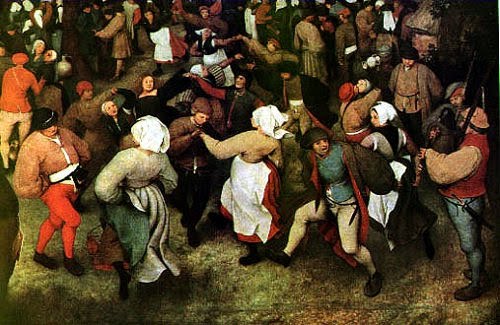 |
Craig White's Literature Courses Historical Backgrounds Renaissance Music |
 A Musical Band from the Renaissance—lots of horns & drums (horn 2nd from right is a sackbut, predecessor to the trombone) |
Earlier times may not have thought of music entirely as we do at the turn of Millennium 3 CE. Instead of a national-to-global business of professional musicians selling amplified and recorded music, earlier music was mostly a local and more acoustically limited affair, often more amateur than professional, and performed for smaller target audiences.
Music often occurred in family or neighborhood settings, in religious services, or here and there in feudal or state courts. ("Courts" here means the extended family or residence of a monarch or nobility, comparable to a concert at the White House or a pop band playing at a billionaire's wedding.)
Such earlier times are easily romanticized—everyday people making their own music rather than paying for it! But people often went without music, and the quality of available music varied widely.
The "Early Music Revival" of the 19th & 20th centuries increased the popularity of Renaissance music in cosmopolitan areas and college towns. An operating principle of the Early Music Revival was "authenticity" through the use of "original instruments" from the music's original time period, including the tuning of instruments according to earlier settings or styles.
Mainline churches sometimes feature performances of early or period music, especially around Christmas. (e.g. Bach Society Houston at Christ the King Swedish Lutheran Church in Rice Village, or Christ Church Cathedral of the local Episcopal diocese.
Big American cities like Houston are often home to early music societies, like Houston Early Music & the Houston Early Music Festival (now happening).
![]()
Discussion question(s):
1. How do these various European pieces resemble or differ from American Indian music (+- dance), or music (+- dance) as we now know it?
2. How may early European music prefigure the USA's dominant culture? In what ways may it seem more universal than cultural?
![]()
Courtly music and dance
Courtly Renaissance dances (Waverly Consort)
Tennessee Renaissance Festival 2012
Tartanic at TX Renaissance Festival
Maryland Renaissance Festival 2011
Philly Phanatic at Pennsylvania Renaissance Fair
Renaissance instrumental music (Josquin de Pres)
![]()
Sacred music of the Renaissance
Palestrina, Pope Marcellus Mass
Tallis Scholars sing Palestrina ("Nunc Dimitis")
Christmas CD of Renaissance Mass by seminary choir
Monteverdi, Vespers for the Blessed Virgin
![]()
Music from Castile, Spain
Tomas Luis de Victoria, Credo from O Magnum Mysterium
Tomas Luis de Victoria, Sanctus
![]()
Music from Renaissance-Baroque Mexico
Chanticleer, Para dar Luz Immortal

Breughel, Wedding Dance
(c. 1566)
Courtly Renaissance dances (Waverly Consort)
formal dancing, highly structured
Tennessee Renaissance Festival 2012
less structured, more improvisational, cf. Celtic music
Tartanic at TX Renaissance Festival
Ren festivals mix all periods and nations, like Xena Warrior Princess
Maryland Renaissance Festival 2011
horns and drums, audience interaction
Renaissance instrumental music (Josquin de Pres)
![]()
Sacred music of the Renaissance
Palestrina, Pope Marcellus Mass
Tallis Scholars sing Palestrina ("Nunc Dimitis")
"Now you dismiss"
English Book of Common Prayer (1662), from Luke 2:29-32, Simeon's words regarding baby Jesus in Temple:
- Lord, now lettest thou thy servant depart in peace according to thy word.
- For mine eyes have seen thy salvation,
- Which thou hast prepared before the face of all people;
- To be a light to lighten the Gentiles and to be the glory of thy people Israel.
voices, no instruments, harmony
formal audience-performance relation
Christmas CD of Renaissance Mass by seminary choir
"Puer natus est" = "A child is born"
Monteverdi, Vespers for the Blessed Virgin
instruments + vocals, dramatic presentation for video
![]()
Music from Castile, Spain
Tomas Luis de Victoria, Credo from O Magnum Mysterium
Tomas Luis de Victoria, Sanctus
![]()
Music from Renaissance-Baroque Mexico
Chanticleer, Para dar Luz Immortal
Yo, la peor de todas (film about Sor Juana)